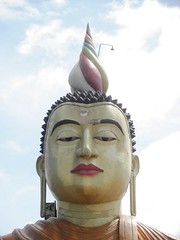A "hill station" is a mostly British creation, the idea being to escape the scorching heat of summer by retreating to resorts at higher elevations. I also suspect that the British quite liked an excuse to build nostalgic little English colonies in the hills. Also the fact that there tended to be a small native population and just one mountain road leading up probably aided greatly in the regulation of municipal melanin levels.
Mt. Abu however has a much longer history as a site of pilgrimages. It is a predictable place to be considered special, as the gargantuan mass of rock on which Mt. Abu (which is more of a plateau) sits juts sharply out of the surrounding plains, reaching several high and dramatic peaks. It was these shrines that I came to see. Most visitors however come for the cool, fresh air and romantic ambiance. It is a traditional getaway for Rajasthani and Gujarati honeymooners, and now increasing numbers of unmarried couples, as Gujarati men profess enthusiastically (and without any solicitation to do so) that taking a girl here for a pleasant romantic weekend is the best way to get laid. There are also large numbers of Jain pilgrims, and some Hindu pilgrims as well. These pious pilgrimages reach a climax during the peak hill station season, which I am sure is purely a coincidence.
Desipte the locals' priorities, I visited the center of Mt. Abu's tourist appeal quite late in my visit. I made it down to the edge of Lake Nakki, a small lake filled with paddle-boats shaped like swans and similar hokey contrivances that lend the area the feeling of a second-rate state park. This impression is reinforced by the profusion of ice-cream stands, cheesy lakeside diners, picnicking families, embarrassed dating couples, swarms of schoolchildren with uniforms straight out of the Where's Waldo? School of Art and Design, and awful music. At one such ice cream stand a man bearing an uncanny resemblance to Saddam Hussein pumped Indian techno, which at first was a forgivable stab at emulating Eurotrash beach music, but just couldn't go the full length of a song without suddenly introducing wailing Hindi voices and the atonal eructations of unidentified brass instruments.
The shrines I found considerably more appealing, though the majority of the well-known ones prohibit photography. Gahhh.The first I went to was the Adhar Devi temple, located up a very long mountainside staircase, as I found out so is every other temple on Mt. Abu. Entering the temple door, you soon find yourself surrounded by the mountain in a narrow crevasse coated in white paint. At the entrance to the shrine itself you are forced to scramble under a ludicrously low-hanging rock and into a cave where there is a striking idol of Durga, the demon-slaying queen bitch of the Hindu pantheon.
From there I proceeded across the plateau to a village called Achalgarh, where there are numerous little temples. Climbing high up the mountainside out of the misguided belief that I was supposed to go that way, I reached the summit and found that it was essentially abandoned, boasting only a handful of brick ruins overgrown with vines. My eye was suddenly caught by a tiny stone staircase leading down along a cliff face. I followed it cautiously past another ruin until at the end of it I saw a brick wall built into the mountainside and a single pair of shoes by the door. I poked inside and found myself in a complex of several small cave chambers, one with a lingam, the other with a large idol, with of candles and incense still burning. To the side of the idol were a pair of minuscule passageways leading into the pitch-black depths of the mountain, concealing unknown horrors or treasures. The owner of the shoes was nowhere to be seen but could not be far away, and the silent blackness gave no clue whether he was sound asleep deep within unseen passages or if he was watching my every move from the fringe of his inky lair. As I lingered and still no sign presented itself, this grew more and more unsettling and I left as quietly as I entered. You may laugh, but I know better than to take my chances explaining my intrusion in a foreign tongue to a zealous, lurking troglodyte.
Finally I made my way back to the main attraction, the Dilwara Jain temples, which are famed for their intricate carving. Above the entrance was a most foreboding sign:
"ENTRY OF LADIES IN MONTHLY COURSE STRICTLY PROHIBITED. OTHERWIS MAY SUFFER"Jain temples have a bunch of odd restrictions which they enforce with varying amounts of zeal. They feel quite strongly about not allowing entry to menstruating women, but inspecting for this particular form of contraband is the one line they are not willing to cross in the name of temple sanctity. Thus the Dilwara temple authorities, as they themselves are powerless to enforce the restriction, merely warn women that they incur the risk of possible divine retribution for their transgression. I feel this is a reasonable compromise. Near the entrance, on a placard purporting to contain 'historical informations', it also says
"THESE TEMPLES SHINE AND SHINE ALMOST ALONE LIKE A BRIGHT STAR IN THE LONG GALAXY OF THE WONDERS OF THE WORLD..."It had better be good.
Words cannot describe how intricately these pure marble temples are carved. The artists were paid proportionally to the mass of the chips and dust they produced whilst carving, and the result is impressive indeed. The most important of these temples, a thousand-year old structure commissioned by the Rajput king who then controlled Gujarat, is about the size of a basketball court. Every possible surface is carved in an almost absurd amount of detail. Columns, ceilings, walls, arches, everything is carved with increasingly fine and minute sculptures, almost like fractals composed of animals and deities. There are, at the very least, hundreds of thousands of carved figures in this one temple alone. I hesitate to say that there may be in excess of a million in the entire compound, though this seems plausible. In addition to the sculptures, the ceilings are spectacularly adorned with panels and domes, each displaying a unique form of the lotus flower, hanging in three-dimensional splendor from the roof, their geometry playing tricks with the light on the pale marble as you move beneath. In the many shrines within the temples are idols. The adornments outside are just sculpture. The idols, though less ornate, are equally amazing. Most of the tirthankara statues are made of impeccably polished marble with silver detailing and a jeweled "third eye" on their foreheads composed of a thumbnail-sized ruby surrounded by rings of diamonds. One of the lesser temples houses a colossal 8-foot tirthankara covered in gold.
OK, 'historical informations', fair enough.
I returned and paid my visit to the town of Mt. Abu, which is almost entirely comprised of hotels and shops catering thereto, then walked out to one of the scenic overlooks. I was trying to scope out where the honeymooners were hanging so that I might deliberately enter their midst and gather information with which to ridicule them in my writing, but they were so shy I felt bad about it. The place was peaceful, and I left them in peace. Peace. What an idea, I thought. Though festive by day, at night the air is still enough to be pierced by the cries of birds and insects. The incessant clamor of bells and horns and honking cars that shakes the unsleeping cities late at night was missing here. I then realized the single best thing about Mt. Abu, the source of its tranquility: everyone here is already married.
Oh, but if only that were true. Though there are no raucous marriage processions here, the rites of evolving Indian courtship smack you in the face. As you watch the sunglasses-wearing Indian men pedal their silly little boats with grim faces as their ladies gaze wistfully off at flocks of snow-white birds alighting upon rocks in the rippling waters of Lake Nakki, you can just see the furrows increasing in the mens' brows, a tally of the hours of such activities they've endured upon this mountain in pursuit of that most elusive of all Indian prey. And then the couples get out the boats, and the women wander off to shop for bangles. Then the men walk up to amiable-looking foreigners, and with much knee-slapping and graphic mimicry, irreverently gush about their chauvinistic ordeals, and you understand why they have to take their women on a vacation all the way up a fucking mountain to get any.
Off in the distance is Guru Sikhar, the highest point in Rajasthan. Though a dwarf by Indian standards, at 1,772 meters it is no anthill. It seemed only fitting to conclude my tour of Rajasthan with a hike to the top. One one side the hills fall sharply down to the barren Rajasthani plains. On the other side, barely visible a short way off through the evening haze, lies Gujarat, where my journey takes me next.
Rajasthan is mine, from its four corners and now from top to bottom. From the dusty smog-choked shithole of Jaipur in the East to the dusty, sandblown piles of dust and sand in the dusty, sandy West; from the dusty, frigid camel-barn called Bikaner in the North, to the dusty, lukewarm elephant stables of Bundi in the South; from the bottom of the emptiest lakes, to the top of the most comparatively un-dusty peaks, I am now the master of this land.
Maharajas,
y'all best step the fuck off.









No comments:
Post a Comment
Commenting Rules:
1)No spam, viruses, porn etc.
2)DO NOT POST GF-B's REAL NAME
3)Remember this is a public website, don't provide sensitive info about yourself in the internet!